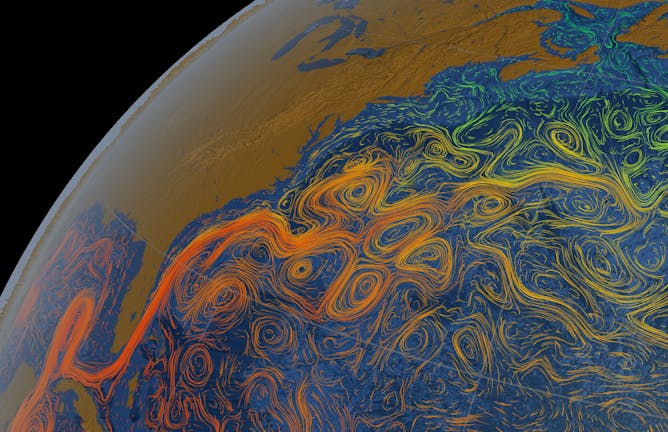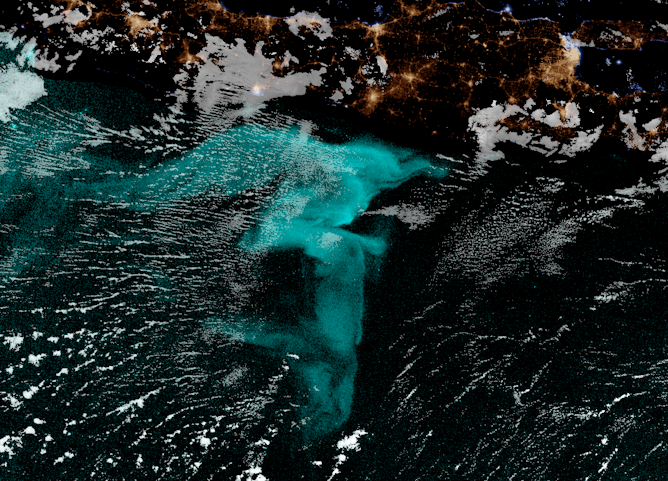|
Hurricane Ida exploded in strength in a matter of hours over the weekend, with wind speeds jumping from 85 miles per hour on Saturday to 150 mph just before the storm slammed the Louisiana coast the next day. Scientists have seen this kind of “rapid intensification” before. Hurricanes Rita, Katrina and Michael all quickly gained strength, and they all shared a key characteristic with Ida – they crossed over parts of large, warm eddies in the Gulf of Mexico.
Nick Shay, a professor of oceanography at the University of Miami, explains where those eddies come from and how they fuel hurricanes. He was part of a team of scientists gathering data on the ocean’s heat content as Ida crossed the Gulf of Mexico. “When these eddies form during hurricane season, their heat can spell disaster for coastal communities around the Gulf,” he writes.
The range of the emerald ash borer, which first arrived in the U.S. in the early 2000s, has expanded to 35 states, and the practice of quarantining wood has not stopped its spread, writes University of Richmond biologist and invasive species specialist Kristine Grayson. She describes lab experiments by the U.S. Department of Agriculture to rely on parasitic wasps to feed on the emerald ash borers’ eggs, and she outlines her own work to speed up this research.
And in a story that features perhaps the most unusual science photo of the week, atmospheric scientist Steven Miller from Colorado State University writes about how his team was able to use satellite imagery to learn more about “milky seas,” when the ocean’s surface creates a steady bright glow from millions of bioluminescent organisms. “Using this technique, we aim to learn about these luminous waters remotely and guide research vessels to them so that we can begin to reconcile the surreal tales [of old] with scientific understanding,” Miller writes.
In other science news this week:
|

A computer animation reflects the temperature change as eddies spin off from the Loop Current and Gulf Stream along the U.S. Coast.
Nick Shay, University of Miami
Ida exploded from a weak hurricane to a powerful Category 4 storm in less than 24 hours, thanks to heat from an ocean eddy. An oceanographer explains its rapid intensification.
|

Emerald ash borer larva cut these feeding galleries on the trunk of a dead ash tree in Michigan.
corfoto via Getty Images
Kristine Grayson, University of Richmond
Biological control strategies curb pests using other species that attack the invader. A biologist explains why it can take more than a decade to develop an effective biological control program.
|

For centuries, sailors have told tales of milky seas – huge swaths of ocean glowing on dark nights, seen in blue in this false–color satellite image.
Steven D. Miller/NOAA
Steven D. Miller, Colorado State University
When conditions are just right in some parts of the Indian Ocean, a type of bacteria will multiply and start to glow. Satellites are helping scientists study these milky seas for the first time.
|
Other good finds
|
-
Luke Montrose, Boise State University; Adam Schuller, Boise State University
To stay healthy, it’s important to understand how wildfire smoke can harm your body and how to protect yourself.
-
Maureen Ferran, Rochester Institute of Technology
It has been six months since the Johnson & Johnson vaccine received emergency use authorization. What does six months of data show about its efficacy, side effects and protection from variants?
-
Robert Schofield, University of Oregon
Many small animals make their teeth and claws from a smooth blend of proteins and heavy elements. These materials can form very sharp tools that make it possible to cut tough substances using tiny muscles.
-
Matthew Woodruff, Emory University
A COVID-19 vaccine does not cause infertility – but it can protect you from the dangerous complications of contracting the virus.
-
Kerry Rippy, National Renewable Energy Laboratory
The US is generating more electricity than ever from wind and solar power – but often it’s not needed at the time it’s produced. Advanced energy storage technologies make that power available 24/7.
-
Glenn J Rapsinski, University of Pittsburgh
An infectious disease doctor explains the science behind COVID-19 vaccines at a level that children – and adults – of all ages can understand.
-
Andrew Read, Penn State
A 2015 paper on chicken virus evolution is being taken out of context and used to fuel fears about COVID-19 vaccines. Its lead author aims to clarify the science in hopes of saving lives.
|
|